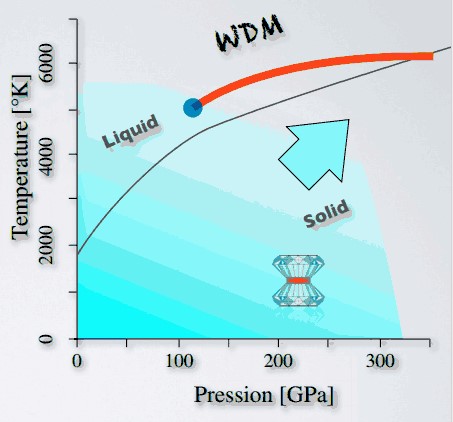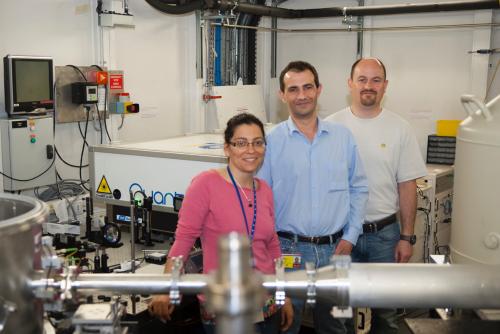- Home
- News
- General News
- ESRF sends shockwaves...
ESRF sends shockwaves (and an X-ray pulse) through iron to prove a new technique
20-06-2014
Scientists have demonstrated a new technique at the European Synchrotron, the ESRF, for investigating how iron, which makes up much of Earth’s core, changes, when placed under the extreme temperature and pressure it is exposed to deep inside Earth. For the first time in a synchrotron the phase transitions of iron have been observed with a single X-ray pulse by linking a portable laser to one of ESRF’s recently upgraded beamlines. Usually, much larger, very high energy lasers or multiple experiments are required to get high quality data of this kind, making the experiments more costly and less accessible. The knowledge gained will help theoreticians modeling unreachable regions at the centre of the Earth.
One way to try and understand the environment inside the Earth’s core and in exoplanets is to recreate the environment that exists there and examine how materials – in this case iron - behave under those conditions. Shocking a sample with a laser is one method for achieving that.
Using a high powered laser the international team heated a sample of iron to over 9000 degrees Celsius and by sandwiching the iron between two layers of diamond, created pressures 4 million times greater than the atmosphere. The compression induced by the power of the laser allows extreme states of matter to be observed beyond the static limitations of a standard diamond anvil cell. As the energy is deposited onto the target in ten billionths of a second, a plasma is created which expands to form a shockwave. The transition of the iron sample from solid to liquid and the solid-solid phase transitions it undergoes were observed by X-rays from the recently upgraded ID24 beamline.

P-T phase diagram indicating the thermodynamical conditions of solid, liquid and warm dense iron. The red line follows the geotherm from outer liquid core to the inner solid core of Earth (as shown in figure above). The blue arrow indicates that in order to reach such P,T conditions and to explore that region of the phase diagram, it is necessary to go beyond static compression with diamond anvil cells, and move towards dynamic compression using high power lasers. CREDIT: Image taken from this presentation by Tommaso Vinci.
Normally such experiments are carried out on a much bigger scale using high power Kilojoule lasers on targets ten times larger than in this case, and the energy needed, a hundred times greater. The team from the Commissariat a l’Energie Atomique (CEA), the ESRF, the Institute Shock Physics (ISP) at the Imperial College London and the Science and Technology Facilities Council (STFC)’s Daresbury Laboratory have proven here that it can be performed successfully on a much smaller scale while taking advantage of the high stability of synchrotron sources to produce high quality data. The coupling of portable lasers to synchrotron beamlines will make these techniques more accessible to a large user community.

The experiment required a careful target design. Each target was composed of a thin (~ 3 microns) foil of iron sandwiched between two layers of diamond (20-50 microns each). Targets were mounted on a rotating wheel device, inserted in a vacuum chamber.
“The success of this method is that you can get high quality data in a single X-ray pulse”, said Raffaella Torchio from the ESRF. “This is very important because it prevents any unwanted anomalies that can arise from repeating the experiment on several different samples – reproducing the exact laser and target conditions is not easy. Doing the experiment with a single pulse means it is much cheaper too. We hope that in the future, laser stations might be installed permanently at synchrotrons, to open this field of research to many users”.
Being able to study hot, dense matter in this way offers valuable information for the theoretical modeling of Warm Dense Matter (WDM), abundant in planetary interiors. It is in these “exotic” states of matter where most of the approximations used in condensed matter physics or in plasma physics break down.

Raffaella Torchio (ESRF), Florent Occelli and Arnaud Sollier (CEA).
The ID24 beamline on which the measurements were performed is among the first beamlines funded by Phase I of the ESRF upgrade to become operational. The gain in focus, brightness and beam stability was key to the success of this technique.
Further information
The team of CEA was responsible for designing and preparing the targets and for the installation of the GCLT laser on beamline ID24.
The team from ISP at the Imperial College, London provided the expertise for measuring the shock velocity using an instrument adapted to the configuration of the experiment.
The team from STFC’s Daresbury Laboratory built the detector and designed, in collaboration with the ESRF, a new very fast acquisition card for the dynamic measurements.
For more information contact raffaella.torchio@esrf.fr
Top image: Interior of our planet. CREDIT: Image taken from a presentation by Tommaso Vinci. See further credit details on the following image.



